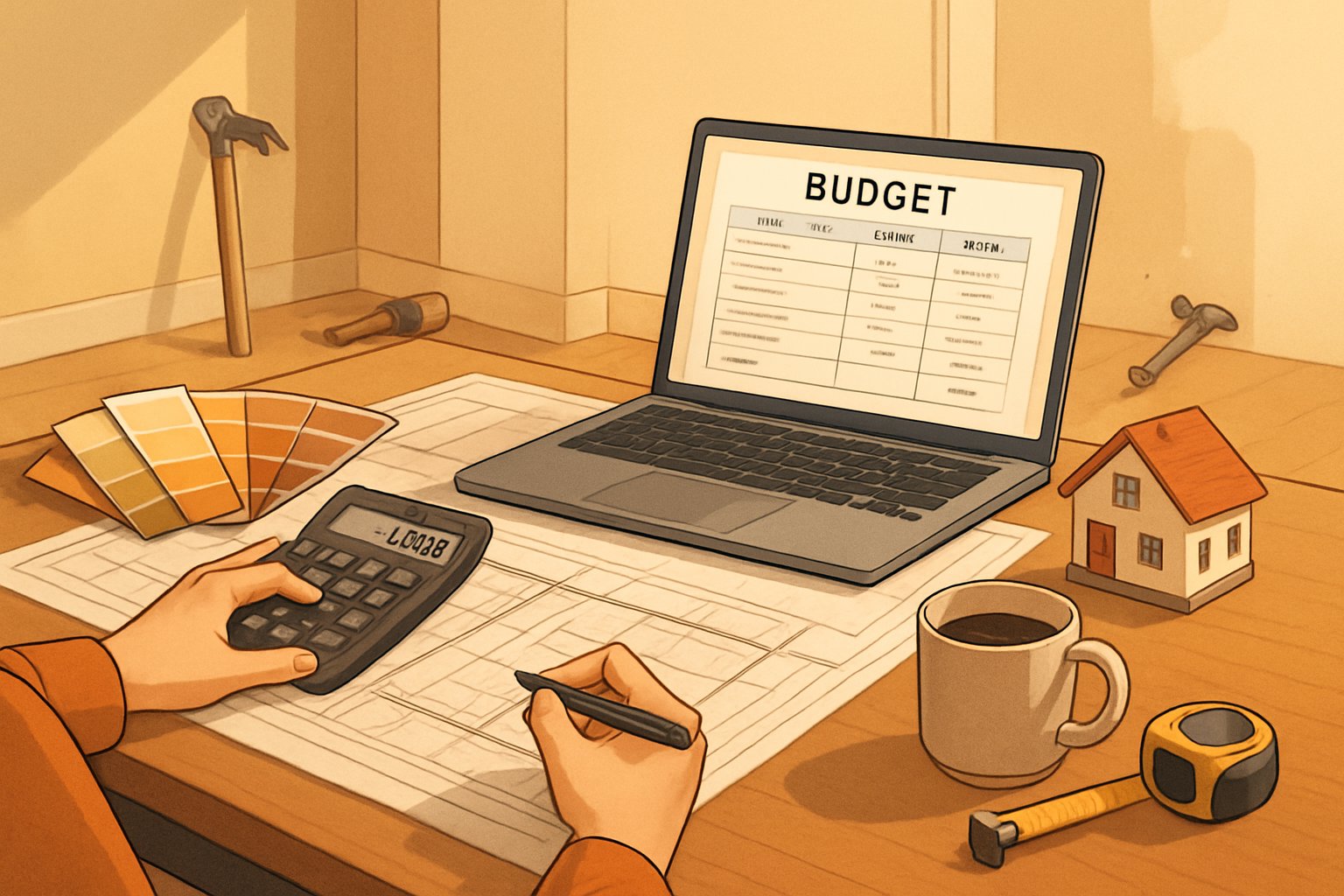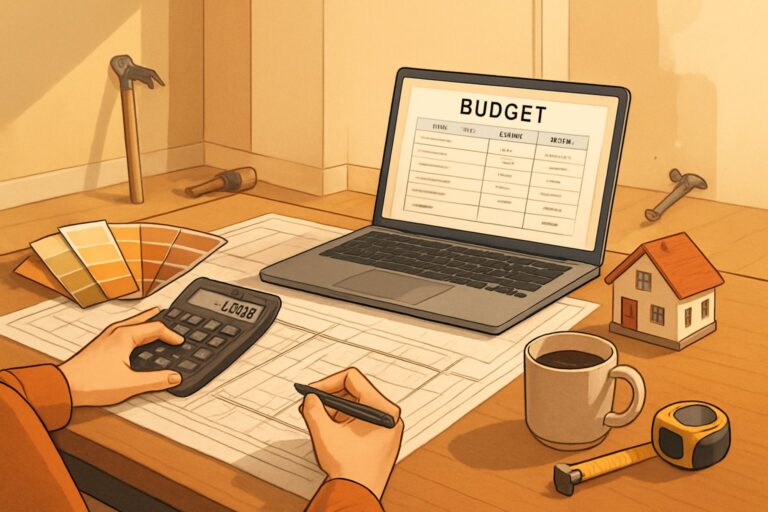Home renovations can start out as exciting dreams, but wow, those costs can sneak up on you fast. Most folks begin with a set budget, then end up spending 20-50% more because they didn’t plan for hidden expenses or take the time to really map things out.

If you want to dodge those nasty budget surprises, add 15-20% to your total for unexpected costs, and get detailed quotes from a few contractors before you start anything. That one move can save you from the most common pitfalls that wreck renovation budgets.
Smart budgeting isn’t just about guessing at material prices. You need to plan for permits, possible structural surprises, living arrangements if you need to move out, and the inevitable changes that pop up once construction begins.
Key Takeaways
- Set aside 15-20% of your total renovation budget for unexpected expenses like hidden damage or permit fees.
- Get detailed written quotes from at least three contractors to understand true project costs.
- Plan for extra costs like eating out, storage, and maybe even temporary housing during big renovations.
Defining Your Renovation Goals and Project Scope

Clear goals and a well-defined project scope are the backbone of any solid renovation budget. Skip this part, and you’ll probably run into surprise costs and delays that could’ve been avoided.
Need a Home Fix – Emergency or Routine?
From leaks and no-heat nights to simple tune-ups, our 24/7 hotline connects you with trusted local pros in minutes.
Determining Essential Improvements
Essential improvements are all about safety, functionality, and structural integrity. You can’t put off these repairs—they need to be first in line for your renovation dollars.
Safety upgrades mean electrical work, plumbing fixes, roof repairs, and foundation jobs. These are the things that can get dangerous or much worse if you ignore them.
Structural problems like water damage, mold, or pests? Deal with those right away. Waiting only makes them more expensive.
Basic functionality covers things like heating and cooling, appliances that actually work, and bathrooms you can use. Start your project here.
Do a thorough home inspection. Walk through each room and jot down anything that makes daily life harder or less safe.
Prioritizing Rooms and Upgrades
Think about which rooms get the most use, what shape they’re in, and how much they’ll boost your home’s value. Focus your energy (and money) where it matters most.
High-impact areas are usually kitchens and bathrooms. These spaces take a beating and can really help resale value when updated.
Living spaces like family rooms and bedrooms come next. Ask yourself where your family actually spends time.
Here’s a quick way to rank your rooms:
| Priority Level | Room Type | Renovation Focus |
|---|---|---|
| 1 | Kitchen, Main Bathroom | Function and safety |
| 2 | Living Room, Master Bedroom | Comfort and aesthetics |
| 3 | Guest Rooms, Basement | Convenience upgrades |
Timing matters too. Some projects have to happen before others—like plumbing or electrical work that affects multiple spaces.
Balancing Needs and Wants
If you want to keep your renovation realistic, you need to know the difference between what you must have and what would just be nice. This is how you avoid blowing your budget.
Needs are essentials: storage, good lighting, working fixtures. These things make your home livable.
Wants are the fun stuff—fancy finishes, luxury extras, or cool design touches. They can usually wait.
Make two lists: one for needs, one for wants. Be honest with yourself about which is which.
Put 70-80% of your budget toward needs, and 20-30% toward wants. That way, you get the important stuff done and still have room for a few upgrades.
Maybe phase in the “wants” over a few years. It spreads out the cost and gives you time to save up for the fun extras.
Assessing Your Financial Situation and Setting a Realistic Budget

Before you build a budget, figure out exactly how much money you’ve got and what your project will actually cost. Be brutally honest about your finances—and don’t start anything without real numbers.
Evaluating Available Funds
Start by adding up your available cash. That means checking and savings accounts, plus any other money you can tap quickly.
Decide how much you can safely use. Most financial pros say keep at least 3-6 months of living expenses untouched, just in case. Only use the rest for renovations.
Look at your monthly income after taxes. Include your regular paycheck and any steady side gigs or bonuses.
List all your debts and monthly bills:
- Mortgage or rent
- Car payments
- Credit cards
- Student loans
- Other recurring stuff
Subtract those from your monthly income. Whatever’s left is what you could use for a renovation loan payment, if you need one.
If your cash doesn’t cover it, check out financing options. Home equity loans, personal loans, or even contractor financing might fill the gap.
Estimating Overall Renovation Costs
Look up what similar projects cost in your area—prices can swing a lot depending on where you live. Local estimates are always better than random online numbers.
Get at least three contractor quotes. You’ll see a range, and you’ll spot any weirdly high or low bids that need a second look.
Break costs into big buckets:
- Labor (usually 35-40% of the total)
- Materials (40-50%)
- Permits and inspections (depends on the job)
- Design fees (if you’re hiring pros)
Go to a few home improvement stores and get real prices for materials. Online estimates can be way off.
Watch out for hidden costs:
- Structural repairs you only find once you start
- Bringing things up to code
- Moving utilities
- Disposal fees for old stuff
Add a 15-20% buffer for surprises. That way, you won’t panic if something pops up mid-project.
Deciding on Budget Limits
Pick a max spending limit based on what you’ve got and what feels comfortable. Don’t go past it—no renovation is worth constant money stress.
Think about your home’s value too. Usually, you shouldn’t spend more than 10-15% of your home’s value on most renovations, or up to 20% for a major kitchen or bath.
Split your budget into must-haves and nice-to-haves. Give top priority to things like safety or structural repairs.
Assign specific dollar amounts for each part of the job. For example, maybe $8,000 for cabinets, $3,000 for appliances, $2,000 for flooring—whatever makes sense for your scope.
Leave 5-10% wiggle room for decisions you’ll make after work starts. It’s almost impossible to plan everything upfront.
Write down your final budget and share it with your contractor and family. It keeps everyone on the same page.
Breaking Down Renovation Expenses
Renovation costs usually break into three big pieces: labor, materials, and appliances or fixtures. Labor often eats up 35-50%, materials take 40-50%, and the rest goes to appliances and fixtures.
Calculating Labor and Contractor Costs
Labor costs swing a lot depending on how complicated the job is and where you live. Electricians and plumbers usually charge $75-150 per hour.
General contractors tack on a 15-25% markup to cover managing the project and wrangling all the different trades.
What makes labor more expensive?
- Timeline – If you rush, expect to pay 20-30% more
- Season – Summer’s busy, so rates go up
- Permits – Complex jobs add $500-2,000
- Site access – Tough spots mean more labor hours
Always get three detailed quotes from licensed contractors. Make sure each one spells out labor hours, rates, and exactly what’s included.
Union contractors usually cost more but often deliver higher quality. Non-union folks might be cheaper, but make sure to check their references carefully.
Estimating Material Costs and Supplier Options
Material prices jump around based on quality, brand, and market swings. Budget options can cost 40-60% less than the fancy stuff, but you might have to replace them sooner.
Major material categories include:
- Structural stuff – Lumber, drywall, insulation ($15-25 per square foot)
- Flooring – $3-15 per square foot installed
- Paint and finishes – $2-5 per square foot
- Hardware – Handles, pulls, switches ($200-800 per room)
Big box stores have low prices, but the selection isn’t great. Specialty suppliers know their stuff and have better materials, but you’ll pay 10-20% more.
Some contractors get 10-30% discounts from suppliers. Sometimes they pass those savings to you—sometimes not.
Order materials early to avoid delays and price hikes, but don’t overdo it or you’ll end up with a storage headache and wasted money.
Identifying Appliance and Fixture Expenses
Appliances and fixtures can really eat up your budget, and they’re easy to underestimate. Kitchen appliances alone can run from $3,000 to $15,000, depending on what you pick.
Typical appliance costs:
- Refrigerators: $800-4,000
- Ranges/cooktops: $600-3,500
- Dishwashers: $400-1,800
- Washers/dryers: $1,200-3,000 per set
Fixtures cover lights, plumbing parts, and electrical outlets. Light fixtures range from $50-500 each, and good faucets are $150-800.
Energy-efficient appliances cost more upfront—usually 20-40% more—but they lower your utility bills over time. Some even qualify for rebates of $200-1,000 each.
Don’t forget installation costs—they add 10-25% to appliance prices. Some stores throw in basic installation, but if you need special wiring or plumbing, that’ll cost extra.
Try to time your purchases with big sales. Black Friday, end-of-model-year, and holiday weekends can save you 20-40% on appliances and fixtures.
Preparing for Hidden and Unexpected Renovation Expenses
Smart homeowners try to build a financial cushion into their renovation budgets. They dig into potential costs before anyone swings a hammer.
Planning for permits, structural issues, and system problems can really help you avoid a budget disaster. It’s not fun, but it’s better than being blindsided halfway through.
Allocating a Contingency Fund
Every renovation budget should have a contingency fund for those curveballs. Most experts say 10-20% of your total budget is a safe bet for the unexpected.
If you’re eyeing a $50,000 kitchen project, set aside $5,000 to $10,000 just in case. Got an older home? You’ll probably want to lean closer to 20%—hidden problems are pretty much guaranteed.
Common unexpected expenses include:
- Hidden water damage or rot
- Outdated electrical systems
- Plumbing repairs or replacements
- Foundation issues
- Code compliance upgrades
Keep your contingency fund separate from your main renovation money. Only dip into it if you hit a true surprise during construction.
Homes built before 1970? They’re notorious for hidden headaches—think asbestos, lead paint, or ancient wiring that needs a total overhaul.
Accounting for Permits and Regulatory Fees
Permit costs catch a lot of people off guard. Depending on your city and the project, they can run from $200 to $5,000 or more.
Projects that usually need permits:
- Electrical work
- Plumbing changes
- Structural modifications
- Room additions
- Kitchen and bathroom remodels
Don’t forget inspection fees—they pile onto permit costs. Most jobs need several inspections at different stages.
Call your local building department early to nail down what you’ll need. Sometimes contractors include permit fees, but not always, so double-check.
Permit delays can stretch your timeline and bump up labor costs. In busy areas, getting approvals might take weeks or even months.
Planning for Structural Problems and Surprises
Once you open up walls or floors, you never really know what you’ll find. If you hit a structural issue, you have to fix it—there’s no way around it for safety and legal reasons.
Typical structural surprises:
- Damaged floor joists or support beams
- Outdated plumbing behind walls
- Faulty electrical wiring
- Foundation cracks
- Termite or pest damage
Plumbing problems love to pop up during kitchen and bath renos. Old pipes often need full replacement once they’re exposed.
Water damage hides behind walls, spreading where you can’t see. Mold removal and structural repairs can easily add thousands to your tab.
Hire a qualified inspector before you start big renovations. A pro can flag potential issues early, saving tons of stress (and cash) down the line.
Financing Your Home Renovation Project
There are a handful of ways to pay for renovations, and each one has its quirks. Home equity options usually come with lower rates, but refinancing can open up bigger budgets for those major overhauls.
Comparing Financing Options
Personal loans are great for smaller projects under $50,000. No collateral needed, but interest rates can swing from 6% up to a whopping 36%.
Credit cards work for tiny upgrades—think under $5,000. Some offer 0% for the first year or so, but after that, rates can jump over 20%.
Home equity loans let you borrow against your house at a fixed rate. You can usually tap up to 80% of your equity, with rates a couple points above prime.
Government programs like FHA 203(k) loans roll purchase and renovation costs together. VA loans help eligible veterans with competitive terms and no down payment required.
| Option | Best For | Rate Range | Loan Amount |
|---|---|---|---|
| Personal Loan | Small projects | 6-36% | Up to $50,000 |
| HELOC | Ongoing projects | Prime + 1-3% | Up to 80% equity |
| Home Equity Loan | Known costs | 6-9% | Up to 80% equity |
| Cash-out Refinance | Major renovations | 3-7% | Up to 80% home value |
Understanding Home Equity Loans and Lines of Credit
A home equity loan gives you a lump sum with fixed payments, usually over 15-30 years. It’s a good fit if you know exactly what your project will cost.
The rate stays the same, so your monthly payments won’t surprise you. Budgeting gets a lot easier this way.
With a home equity line of credit (HELOC), you draw funds as needed—kind of like a credit card backed by your home. You can borrow up to your approved limit.
HELOCs have a draw period (5-10 years), followed by a repayment phase (10-20 years). Rates move with the market, so payments can change.
During the draw period, you might only pay interest. Once repayment starts, principal payments kick in and your monthly bill goes up.
Both options use your home as collateral. Fall behind on payments, and foreclosure becomes a real risk.
Leveraging Refinancing Solutions
Cash-out refinancing replaces your old mortgage with a bigger one. The extra cash goes toward renovations, and you might even lower your monthly payment if rates have dropped.
This move makes sense if current rates beat your old mortgage rate. You can access up to 80% of your home’s value.
Rate-and-term refinancing just tweaks your loan terms—no cash out, but lower rates can free up money for renovations.
Refinancing comes with upfront costs: appraisals, origination fees, closing costs—usually 2-5% of the loan. You’ll want to crunch the numbers to see if it’s worth it.
Cash-out refis reset your mortgage to 30 years, so you’ll pay more interest over time—even if you get the renovation funds you need.
Maximizing Value and Cost Efficiency
Choosing the right materials and upgrades can really stretch your renovation dollars. Energy-efficient improvements often pay off the most, both in lower bills and resale value.
Choosing Cost-Effective Materials
You don’t have to splurge to get a high-end look. Laminate flooring, for example, looks a lot like hardwood but costs 30-50% less—and it holds up surprisingly well.
Budget-Friendly Material Swaps:
- Quartz countertops instead of natural stone—save $20-40 per square foot
- Vinyl plank flooring mimics wood for $2-7 per square foot (hardwood runs $8-15)
- Ceramic subway tiles at $1-3 per square foot versus $8-15 for stone
Spend more on kitchen cabinets and bathroom vanities. These get daily use and set the tone for the whole room.
Buy materials directly when you can—contractors often mark them up. Many suppliers will cut homeowners a deal if you ask.
Check out factory seconds or overstock for things like tiles or fixtures. Sometimes you’ll find a tiny scratch that knocks off hundreds, but the item works just fine.
Investing in Energy-Efficient Upgrades
Energy-efficient upgrades shrink your utility bills and boost your home’s value. Insulation upgrades, in particular, offer the best bang for your buck.
Top Energy-Efficient Upgrades:
- Attic insulation ($1,500-3,000) saves $200-600 a year
- LED lighting uses 75% less energy and lasts up to 25 years
- Energy Star appliances cut electricity use by 10-50% depending on the model
Replacing windows is smart in really hot or cold climates. Double-pane windows can cut heating and cooling costs by 12-15% a year.
Smart thermostats cost $200-300 to install, but you could save 10-15% on heating and cooling. Plus, buyers love them when it’s time to sell.
Upgrading the HVAC system makes your home more comfortable and efficient. High-efficiency units might qualify for up to $2,000 in federal tax credits.
Considering Resale Value and Return on Investment
Renovation projects don’t all pay back the same when you sell. Kitchens usually recoup 60-70%, bathrooms 55-65%—not bad, but not a total return.
High-Return Renovation Projects:
| Project | Average Cost | Resale Value Added |
|---|---|---|
| Minor kitchen remodel | $25,000 | $17,000-20,000 |
| Bathroom renovation | $15,000 | $10,000-12,000 |
| Deck addition | $12,000 | $8,000-10,000 |
Stick with upgrades that appeal to most buyers. Neutral colors and classic looks tend to hold value better than trendy stuff that might look dated in a few years.
Don’t over-improve for your neighborhood. Spending over 10% of your home’s value on renos rarely pays off.
Think local—what sells in your area? Pools are great in Florida, but maybe not so much in Vermont.
If you’re moving in under five years, focus on cheap, high-impact fixes like painting or landscaping. Big investments take time to pay off.
Frequently Asked Questions
Renovation budgets throw everyone a few curveballs. Here are some of the most common questions about costs, tracking, and planning.
What are the essential steps in creating a realistic budget for a home renovation project?
Building a real renovation budget comes down to five steps. First, figure out your total funds—savings, loans, whatever you’ve got.
Next, research local costs for labor and materials. Grab a few contractor quotes to get a sense of what’s normal.
Break your budget into categories. Usually, labor eats up 30-35%, while materials take about 40%.
Set your priorities. List out must-haves versus nice-to-haves so you know where to spend and where to cut if needed.
Finally, set aside a 10-20% contingency fund for the stuff you just can’t predict. Trust me, something always pops up.
How can you ensure that all potential costs are accounted for in a renovation budget?
Covering all your bases means doing your homework and asking the pros. Get detailed estimates that include labor, materials, permits, and inspections.
If you’re hiring an architect or designer, add their fees to your budget. Their expertise can help you avoid expensive mistakes.
Don’t forget hidden costs: electrical or plumbing upgrades to meet code, or structural repairs like rot or foundation fixes.
Look up permit requirements in your area. Permits can add time and money, and skipping them is a gamble you don’t want to take.
Get several contractor bids. Good pros will spot things you might miss and help you avoid budget blowouts.
What strategies can homeowners use to avoid overspending during a renovation?
It’s easy to lose track of expenses during a renovation. Tracking costs as they happen, whether with an app, a simple spreadsheet, or even a renovation tool, keeps spending visible across all categories.
Set firm spending limits for each part of your budget. When one category hits its ceiling, you can adjust before things get out of hand.
Try negotiating with vendors and contractors. You’d be surprised—suppliers often have wiggle room, or they might offer discounts on bulk buys.
Make trade-offs where it counts. Splurge on durable stuff like flooring and countertops, but save on the purely decorative bits.
Watch out for scope creep. If you keep adding features or upgrades not in the original plan, the budget balloons fast.
In what ways can unexpected expenses be managed effectively throughout the renovation process?
Set aside a contingency fund. Most folks recommend 10-20% of the total budget to cover those “didn’t-see-that-coming” costs.
Talk with your contractors regularly. A weekly check-in helps catch problems early, before they snowball into expensive headaches.
If one area comes in under budget, move that money to cover surprises elsewhere. Flexibility like this can really help.
Have backup material options ready. If your first choice gets too pricey or goes out of stock, you won’t face delays or extra costs.
When surprises pop up, prioritize safety and function over looks. Electrical issues, for example, should always come before cosmetic fixes.
What are the best practices for adjusting your renovation budget when facing unforeseen challenges?
Reassess your priorities if things change. Focus on essentials, and push nice-to-have upgrades to a later phase if needed.
Look for alternative materials or finishes. Local suppliers might have similar options for less money than imported brands.
Try negotiating payment schedules with contractors. Spreading out payments can ease cash flow when you hit unexpected bumps.
Consider a phased approach. Breaking the renovation into stages lets you spread out costs and save up between phases.
If a contractor suggests a pricey repair, get a second opinion. Sometimes, another pro will say it’s not really necessary.
How important is it to include a contingency fund in a home renovation budget?
A contingency fund is honestly a must for any home renovation project. Without that extra bit of financial wiggle room, you could easily run out of cash when something unexpected pops up.
Renovations often reveal hidden headaches—think old wiring or surprise water damage. Suddenly, the budget balloons by thousands, and you’re left scrambling.
Most folks recommend setting aside 10-20% of your total project cost for contingencies. If you’re dealing with an older house or planning a big overhaul, you might want to bump that number even higher.
With a contingency fund, you’re less likely to make rushed, regrettable choices just because the money’s tight. You can actually fix problems the right way, instead of settling for band-aid solutions.
And honestly, knowing you’ve got that buffer just makes the whole process less stressful. Wouldn’t you rather focus on making your place awesome instead of sweating every surprise expense?







Leave a Reply